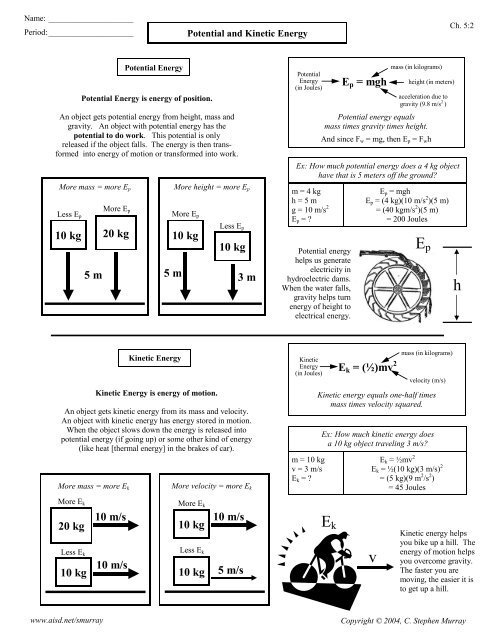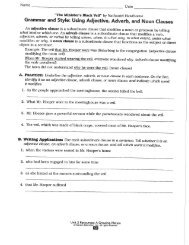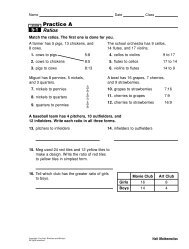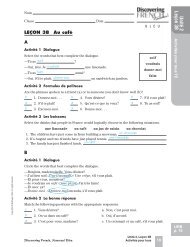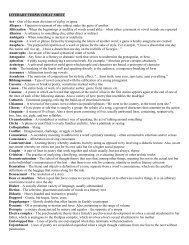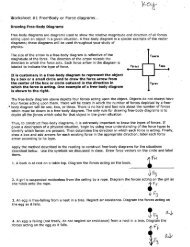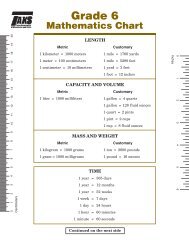Potential and Kinetic Energy
Potential and Kinetic Energy
Potential and Kinetic Energy
- No tags were found...
You also want an ePaper? Increase the reach of your titles
YUMPU automatically turns print PDFs into web optimized ePapers that Google loves.
Name: _____________________Period: _____________________<strong>Potential</strong> <strong>and</strong> <strong>Kinetic</strong> <strong>Energy</strong>Ch. 5:2<strong>Potential</strong> <strong>Energy</strong><strong>Potential</strong> <strong>Energy</strong> is energy of position.An object gets potential energy from height, mass <strong>and</strong>gravity. An object with potential energy has thepotential to do work. This potential is onlyreleased if the object falls. The energy is then transformedinto energy of motion or transformed into work.<strong>Potential</strong><strong>Energy</strong>(in Joules)E p = mghmass (in kilograms)<strong>Potential</strong> energy equalsmass times gravity times height.And since F w = mg, then E p = F w hheight (in meters)acceleration due togravity (9.8 m/s 2 )Ex: How much potential energy does a 4 kg objecthave that is 5 meters off the ground?More mass = more E pMore E pLess E p10 kg 20 kg5 mMore height = more E pMore E p10 kgLess E p10 kg5 m 3 mm = 4 kgh = 5 mg = 10 m/s 2E p = ?<strong>Potential</strong> energyhelps us generateelectricity inhydroelectric dams.When the water falls,gravity helps turnenergy of height toelectrical energy.E p = mghE p = (4 kg)(10 m/s 2 )(5 m)= (40 kgm/s 2 )(5 m)= 200 JoulesE ph<strong>Kinetic</strong> <strong>Energy</strong><strong>Kinetic</strong> <strong>Energy</strong> is energy of motion.An object gets kinetic energy from its mass <strong>and</strong> velocity.An object with kinetic energy has energy stored in motion.When the object slows down the energy is released intopotential energy (if going up) or some other kind of energy(like heat [thermal energy] in the brakes of car).More mass = more E kMore velocity = more E k<strong>Kinetic</strong><strong>Energy</strong>(in Joules)m = 10 kgv = 3 m/sE k = ?E k = (½)mv 2mass (in kilograms)velocity (m/s)<strong>Kinetic</strong> energy equals one-half timesmass times velocity squared.Ex: How much kinetic energy doesa 10 kg object traveling 3 m/s?E k = ½mv 2E k = ½(10 kg)(3 m/s) 2= (5 kg)(9 m 2 /s 2 )= 45 JoulesMore E k20 kgLess E k10 kg10 m/s10 m/sMore E k10 kgLess E k10 kg10 m/s5 m/sE kv<strong>Kinetic</strong> energy helpsyou bike up a hill. Theenergy of motion helpsyou overcome gravity.The faster you aremoving, the easier it isto get up a hill.www.aisd.net/smurrayCopyright © 2004, C. Stephen Murray
Name: _____________________Period: _____________________Ch. 5:21. F or F w = _________________8 w2. v = ______________________8 N3. p = ______________________8 m4. h = ______________________8 kgm/s5. W or E= __________________8 J6. P = ______________________8 m/s<strong>Potential</strong> (E p ) or <strong>Kinetic</strong> (E k ) <strong>Energy</strong>___ A car is traveling 45 mph.___ A rock is on a ledge 5 meters high.___ A car is resting at the top of a hill.___ A ball is thrown into the air <strong>and</strong> is still moving.___ A ball rolling on the ground.Circle the one with more <strong>Kinetic</strong> <strong>Energy</strong>1. <strong>Kinetic</strong><strong>Energy</strong>2. <strong>Potential</strong><strong>Energy</strong>3. Work4. Joules5. hA. Uses energy <strong>and</strong> can create energy; calculatedby multiplying force times distance.B. How far above the ground an object is.C. <strong>Energy</strong> of motion.D. Units for energy <strong>and</strong> work.E. <strong>Energy</strong> of position.Circle the one with more <strong>Potential</strong> <strong>Energy</strong>A 25 kg mass or a 30 kg mass at the top of a hill?A car at the top of the hill or the bottom of a hill?A plane on the ground or a plane in the air?A full plane or an empty plane (both are flying)?A 4 kg rock is rolling 10 m/s. Find its kinetic energy.A 25 kg mass or a 30 kg mass going 5 m/s.Two 10 kg masses, one going 75 m/s, one going 45 m/s.A car at rest or a car rolling down a hill.A heavy bike or a light bike.Calculate the potential energy of a 5 kg object sitting on a3 meter ledge.__________________________________________________A rock is at the top of a 20 meter tall hill. The rock has a massof 10 kg. How much potential energy does it have?______________________________________________A 8 kg cat is running 4 m/s. How much kinetic energy does ithave?______________________________________________A rolling ball has 18 joules of kinetic energy <strong>and</strong> is rolling3 m/s. Find its mass.__________________________________________________A 25 N object is 3 meters up. How much potential energy doesit have. (Hint, notice the units of the object.)______________________________________________A 4 kg bird has 8 joules of kinetic energy. How fast is it flying?__________________________________________________How high up is a 3 kg object that has 300 joules of energy?______________________________________________Find the work done by a 25 N force applied for 6 meters.www.aisd.net/smurrayCopyright © 2004, C. Stephen Murray


